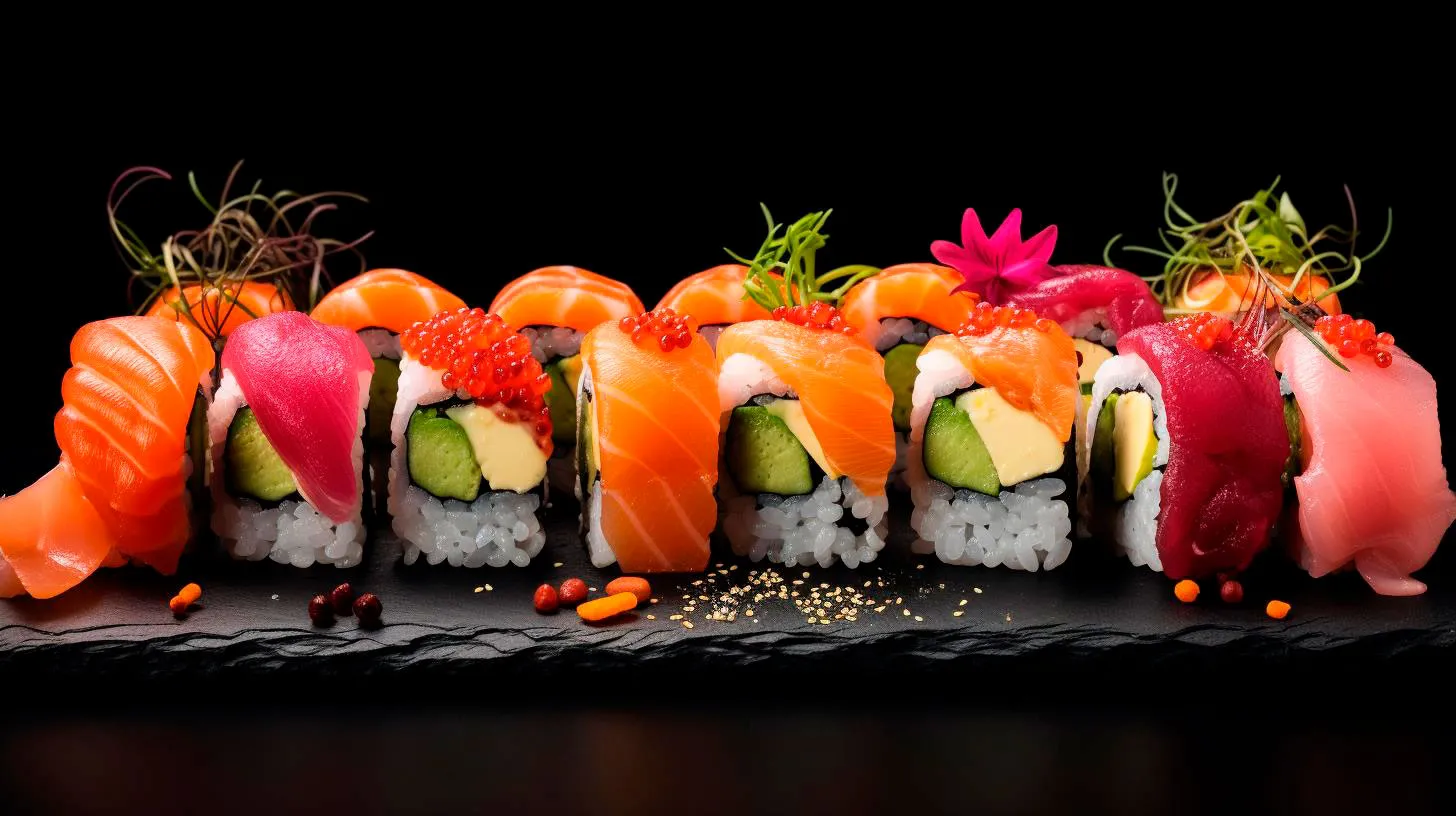Exploring Molecular Gastronomy in Contemporary Sushi Cuisine
In this article, we will delve into the world of molecular gastronomy in contemporary sushi cuisine and explore how it is revolutionizing the way we experience this beloved dish.
The Science Behind Molecular Gastronomy
Molecular gastronomy is a culinary discipline that investigates the chemical and physical transformations that occur during cooking. It focuses on understanding the scientific principles behind cooking techniques, ingredient behavior, and flavor combinations. By applying this knowledge, chefs can create dishes that tantalize not only our taste buds but also our visual and olfactory senses.
Through the use of various techniques and tools, molecular gastronomy offers limitless possibilities for chefs to experiment with ingredients and presentation styles. It allows them to transform classic dishes into stunning works of art, while still maintaining the essence of the original flavors.
Molecular Gastronomy in Sushi Creation
When molecular gastronomy meets sushi, the results are nothing short of extraordinary. Chefs combine traditional sushi-making techniques with innovative molecular gastronomy methods to create visually stunning and delectable pieces of edible art. Here are some key ways in which molecular gastronomy is revolutionizing contemporary sushi cuisine:
Flavor Manipulation
Using techniques like spherification, chefs can create flavor-packed spheres that burst in your mouth, releasing delightful flavors. From soy sauce spheres to wasabi spheres, these tiny explosions of taste enhance the overall experience of eating sushi.
Texture Transformation
Molecular gastronomy techniques allow chefs to play with textures in sushi. They can create crunchy toppings using liquid nitrogen to freeze ingredients instantly, resulting in a pleasant surprise and contrasting texture when you bite into the sushi.
Visual Enhancements
Molecular gastronomy enables chefs to create visually stunning sushi presentations. By incorporating colorful powders, edible flowers, and other creative elements, each sushi roll becomes a work of art that is as visually captivating as it is delicious.
Umami Explosion
Umami, also known as the fifth taste, is a savory flavor that molecular gastronomy can amplify in sushi. Chefs use innovative techniques like umami extraction and encapsulation to intensify the umami experience, making each bite an explosion of flavor.
The Advantages of Molecular Gastronomy in Sushi
The integration of molecular gastronomy into sushi cuisine offers several advantages:
- Enhanced Creativity: Molecular gastronomy allows chefs to think outside the box and experiment with new ingredients, flavors, and presentations, resulting in truly unique and memorable sushi creations.
- Elevated Dining Experience: By incorporating scientific techniques, chefs can elevate the dining experience, offering guests a multisensory journey that engages their taste buds, sight, and smell.
- Expanded Flavor Profiles: Molecular gastronomy enables chefs to extract and intensify flavors, creating a broader range of taste sensations in each sushi bite.
- Improved Textures: With the use of molecular gastronomy techniques, chefs can manipulate textures, adding an element of surprise and delight to the sushi eating experience.
Key Takeaways
Molecular gastronomy has truly transformed contemporary sushi cuisine, unleashing a new world of flavors, textures, and presentations. By combining science and artistry, sushi chefs are pushing the boundaries of what is possible in the culinary world.
- Molecular gastronomy techniques like spherification, texture transformation, visual enhancements, and umami amplification enhance the overall sushi experience.
- Molecular gastronomy in sushi allows for enhanced creativity, an elevated dining experience, expanded flavor profiles, and improved textures.
- Contemporary sushi cuisine is a feast for the senses, showcasing the fusion of tradition and innovation.
As sushi continues to evolve, we can only anticipate even more groundbreaking creations that molecular gastronomy will bring to our plates. So, the next time you indulge in a contemporary sushi experience, savor each bite, knowing that there’s a whole world of culinary science behind it.
New Tools and Technologies Revolutionizing Sushi Preparation
From automated sushi machines to cutting-edge knife techniques, these advancements are revolutionizing the way sushi is made and enjoyed.
The Rise of Automated Sushi Machines
Automated sushi machines have become a game-changer in the sushi industry. These machines are designed to automate various aspects of sushi preparation, streamlining the process and increasing efficiency. Here are some key features and advantages:
- Speed and Efficiency: Automated sushi machines can prepare sushi rolls at a much faster pace compared to traditional methods. This allows restaurants to serve more customers in a shorter amount of time.
- Consistency: These machines ensure consistent quality and shape for each sushi roll, eliminating human errors and inconsistencies.
- Customization: Some automated sushi machines offer customization options, allowing customers to choose their preferred ingredients and create personalized sushi rolls.
- Cost-effectiveness: By reducing the need for skilled sushi chefs, automated sushi machines help lower labor costs for restaurant owners.
According to industry statistics, it is estimated that over 80% of sushi rolls in Japan are made using automated machines, highlighting their widespread adoption and success in the industry.
The Art of Knife Techniques
While automated machines have certainly revolutionized sushi preparation, traditional knife techniques still play a crucial role in creating masterful sushi dishes. Skilled sushi chefs undergo years of training to develop their knife skills, a craft that takes precision and expertise. Here are some key takeaways regarding knife techniques:
- Meticulous Precision: Sushi chefs employ precise knife movements to ensure each slice of fish or vegetable is cut with accuracy and finesse.
- Enhanced Flavor: The way sushi ingredients are cut can impact the taste and texture of the final dish. Proper knife techniques allow for the ideal presentation and distribution of flavors.
- Timeless Tradition: Knife skills have been passed down from generation to generation, preserving the essence of Japanese culinary heritage.
It is fascinating to note that the world record for the most sushi pieces made in one hour using traditional knife techniques is held by chef Hiromu Inagaki, who crafted an astounding 9,388 sushi pieces within 60 minutes.
Technology meets Tradition: The Sushi Robot
Combining traditional sushi techniques with cutting-edge technology, the sushi robot is another tool revolutionizing the sushi industry. Advancements in robotics have made it possible to automate the intricate process of molding sushi rice into perfect shapes, such as nigiri and maki rolls. Here are some key features of the sushi robot:
- Precision and Speed: Sushi robots can mold rice with incredible precision, ensuring consistent size and shape for each piece.
- Hygiene and Food Safety: These robots are designed to maintain high levels of cleanliness and minimize human contact, reducing the risk of contamination.
- Increased Efficiency: By automating the rice molding process, sushi robots enhance the overall efficiency of sushi preparation, allowing chefs to focus more on the artistic aspects of sushi creation.
According to recent data, the global market for sushi robots is projected to grow at a CAGR of 6.7% from 2021 to 2026, indicating the significant impact and potential of this technology in the sushi industry.
Final Thoughts
As sushi continues to captivate taste buds around the world, the fusion of new tools and technologies with traditional craftsmanship is revolutionizing the art of sushi preparation. Automated sushi machines, knife techniques, and sushi robots are transforming the way sushi is made, enhancing efficiency, consistency, and customization. Embracing these advancements allows sushi restaurants to meet the growing demands of customers while preserving the essence of this beloved culinary tradition. Whether it’s the speed of an automated sushi machine or the precision of a skilled chef’s knife, technology is creating an exciting future for sushi enthusiasts and culinary experts alike.
Understanding Umami: The Secret Ingredient in Modern Sushi
In this article, we delve into the concept of umami, its significance in sushi, and how it has revolutionized the world of culinary delights.
The Origins of Umami
Umami, which translates to “pleasant savory taste,” is one of the five basic tastes, alongside sweet, sour, salty, and bitter. First identified by Japanese scientist Kikunae Ikeda in the early 20th century, umami has since gained recognition worldwide for its unique flavor profile and its ability to enhance the overall taste of dishes.
Umami is derived from glutamic acid, an amino acid found abundantly in various ingredients, such as meat, seafood, vegetables, and fermented foods. It was initially believed that umami was only present in traditional Japanese food, but research has shown that it exists in cuisines from different cultures as well.
- Umami-rich ingredients include mushrooms, soy sauce, miso paste, seaweed, and fish, like bonito.
- Umami taste is often described as savory, brothy, or meaty.
- Umami contributes to the complexity and balance of flavors in dishes.
Umami and Sushi
Now, let’s explore the significance of umami in sushi. Sushi, which originated in Japan, is a culinary work of art that combines vinegared rice with various ingredients, commonly including raw fish, seafood, and vegetables. Umami plays a vital role in elevating the overall taste experience of sushi.
The umami taste is most pronounced in sushi through the use of ingredients like soy sauce, wasabi, and of course, the fish itself. The combination of these umami-rich elements creates a harmonious blend of flavors, leaving the palate craving for more. The use of seaweed, known as nori, to wrap sushi is another clever way to incorporate umami into this delicacy.
- Umami is responsible for enhancing the taste of raw fish, bringing out its natural flavors.
- The combination of umami-rich ingredients creates a symphony of flavors in your mouth.
- Seaweed, an umami-packed ingredient, adds both taste and texture to sushi.
Umami’s Influence on Modern Sushi
With the growing popularity of sushi worldwide, the evolution of this traditional Japanese dish has led to the emergence of modern sushi rolls. These rolls often incorporate innovative combinations of ingredients to cater to diverse palates. Umami has played a significant role in expanding the possibilities and creating more complex flavors in modern sushi.
Modern sushi chefs are constantly experimenting with umami-rich ingredients and techniques to surprise and delight their customers. From adding truffle oil or avocado for an extra umami boost to using unique sauces and toppings, umami has become a cornerstone in creating exciting sushi creations.
- Modern sushi rolls incorporate umami-rich ingredients like cream cheese, mango, and jalapeños to add unique flavor profiles.
- Umami’s versatility allows sushi chefs to satisfy a wide range of taste preferences.
- The umami taste has become an essential component in attracting sushi lovers from all walks of life.
Key Takeaways
Understanding the role of umami in modern sushi is crucial in appreciating this culinary masterpiece. Here are some key takeaways:
- Umami is the fifth taste, described as savory and brothy, found abundantly in various ingredients.
- In sushi, umami brings out the natural flavors of raw fish and creates a balanced taste experience.
- Modern sushi rolls owe their complexity and popularity to umami-rich ingredients and innovative combinations.
So, the next time you indulge in a delectable sushi roll, savor the umami experience and revel in the secret ingredient that makes it truly exceptional.
Merging Tradition and Innovation: The Artistry of Modern Sushi Chefs
They are combining traditional techniques with cutting-edge technology and creative ingredients to create mind-blowing culinary experiences. In this article, we will explore the artistry of modern sushi chefs, their innovative techniques, and the advantages they bring to the table.
The Evolution of Sushi
Sushi originated in Japan as a way to preserve fish by fermenting it with rice. Over time, it evolved into the popular dish we know today – a combination of vinegared rice, fresh fish, and various other ingredients. Traditional sushi chefs would spend years perfecting their skills, learning the proper way to prepare sushi and present it to their customers. While the fundamentals of sushi remain the same, modern chefs have found new ways to elevate this centuries-old dish.
Embracing Technology
One of the ways modern sushi chefs are pushing the boundaries is by embracing technology. While traditional sushi-making requires years of practice to achieve perfection, some chefs are turning to machines to assist in the process. For example, sushi rice cookers allow chefs to prepare the perfect batch of rice consistently. This not only saves time but also ensures a consistent texture and flavor.
In addition, some sushi restaurants are incorporating robotic arms into their kitchens. These high-tech gadgets can create intricate sushi rolls with precise cuts and beautiful presentation. While the chef still plays a crucial role in the creative process, the use of technology enables them to experiment with new shapes and designs that were once considered unimaginable.
Creative Ingredients
Modern sushi chefs are also known for their creative use of ingredients. While traditional sushi typically features raw fish, modern chefs are exploring new flavors and textures. They are incorporating unique ingredients like truffles, foie gras, and even fruits into their creations. These unexpected combinations add a new level of excitement to the dining experience and attract a wider range of clientele.
Key Takeaways
- Modern sushi chefs are merging tradition and innovation to create remarkable culinary experiences.
- By embracing technology, chefs can save time and achieve consistent results.
- Creative ingredients like truffles and foie gras bring new flavors and textures to traditional sushi.
- The use of technology enables chefs to experiment with new shapes and designs for visually stunning presentations.
- Modern sushi chefs attract a broader customer base with their innovative techniques and creative menu options.
In Conclusion
The artistry of modern sushi chefs lies in their ability to merge tradition and innovation. While they respect the centuries-old techniques passed down from their predecessors, they are not afraid to push the boundaries and infuse their creations with unique flavors and designs. By embracing technology and experimenting with creative ingredients, they offer diners a one-of-a-kind culinary experience that pays homage to the past while embracing the future. So, the next time you sit down at a modern sushi bar, prepare to be amazed by the stunning creations that blend tradition and innovation in every bite.


